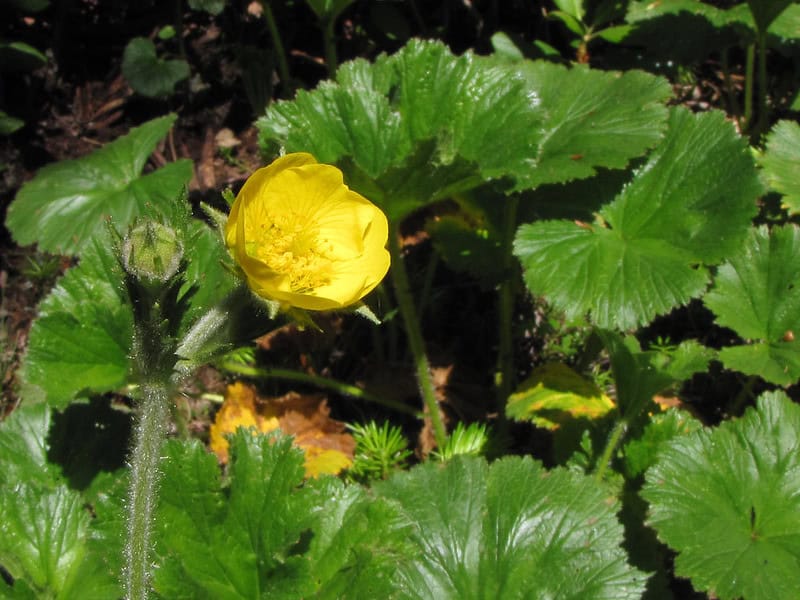
Appalachian Avens Facts
- The informative term of Appalachian Avens serves as the most frequently used common name for this remarkable work of evolution. The plant does have alternate titles, though. These include such similar terms as cliff avens and spreading avens.
- Among scientists, however, it’s better known by its technical moniker. Thankfully, that’s a comparatively simple term for the layperson to pronounce. That’s because this wonder of Nature bears the relatively simple official name of the Geum radiatum.
- This Angiosperm received that easy to pronounce name due to the efforts of the respected French botanist, André Michaux. He recorded the first acknowledgement of the plant as a separate and distinct species in the late 19th century.
- Regardless of which term one chooses to employ, it remains an intriguing beauty. Sadly, though, it has an extremely limited range. It also exists in only 11 known small groupings. Surprisingly, however, the IUCN currently has no listing for it on its Red List.
- The country in which this marvelous Eudicots appears does hold such a listing, however, on its own scale. On that system, the Appalachian Avens presently lists as Imperiled. The flora made its first appearance on the list with that status in 1990.
- It now faces multiple threats to its continued existence, due to its situation. Human recreational activities pose a serious danger, given its location. Poaching of the delicate plant, development of the region, and, of course, climate change, now endanger it.
Related Articles
Appalachian Avens Physical Description
The eye-catching Appalachian Avens does exactly that for most people fortunate enough to encounter it. This marvel of Nature generally does so, however, due to its beauty, rather than sheer size. That’s due to the fact that, depsite its other attributes, it’s a small flora.
The beautiful plant also tends to spread outward, rather than extending vertically, beyond a small height. Most specimens produce thin stems that reach heights measuring from 8 – 20 in (20 – 50.8 cm). Most individual plants, though, tend to stay closer to the shorter height.
This remarkable perennial herb produces a rhizome that spreads beneath the soil. This mot commonly occurs in a horizontal position. In most instances, what appears to be multiple plants actually represents a single plant, along with clones it produces vegetatively.
From each rhizome, multiple circular groupings of leaves develop. This intriguing foliage typically reaches a relatively large size. Each leaf further displays a definite kidney-shaped form. These also have a waxy covering, appearing over a dark green background.
The same foliage on the Appalachian Avens additionally manifests uneven, toothed edges. Each thin stem generally produces between 2 – 5 of these sstructures. The nature of the stems tends to cause these to appear in comparatively dense clusters across the entire plant.
At the end of each stem, 1 -3 small flowers appear. These each display 5 lance-shaped sepals, and 5 petals. Those same petal average 0.5 – 0.8 in (1.3 – 2 cm) in length. Its flowers show a brilliant yellow hue. The fruit is a hard, dry, elongated bean-like structure.
- Kingdom: Plantae
- Phylum: Anthophyta
- Class: Dicotyledoneae
- Order: Rosales
- Family: Rosaceae
- Genus: Geum
- Species: G. radiatum
Appalachian Avens Distribution, Habitat, and Ecology
The amazing Appalachian Avens developed as native to a region of the world already well known for its abundance of natural beauty. The location of that zone of habitation won’t surprise anyone, though. That’s because its very name clearly gives that data away.
This attention-grabbing product of evolution evolved as endemic to a very small and specific portion of North America. More precisely, it lives in the eastern section of the United States. There, as the name implies, it lives in only one region of the Appalachian Mountains.
The exact region it makes its home in consists of the border region between the states of Tennessee and North Carolina. There, however, it displays decided, and limiting, preferences for its choice of habitat. It lives on only a handful of mountain tops above 4,367 ft (1,310 m).
The impressive Angiosperm further requires very specific types of soil conditions to thrive. The plant develops on steep, usually nearly vertical cliff faces. These also must be completely exposed to the elements, especially sunshine, and with gravelly, acidic soil.
Though it mainly spreads via its rhizomes, the Appalachian Avens also spreads via pollination as well. Primary pollinators of the natural marvel include various local insect species. This mainly consists locally prevalent types of bees and flies, alog with a few others.
Blooms typically develop from June to September. The fruits then follow in September to October. Evidence indicates its presence in this region since the last Ice Age. It’s currently unknown if it ever appeared anywhere outside this highly restricted region.
Species Sharing Its Range
Check out our other articles on 5 Beautiful North American Butterflies, Sei Whale, Sacred Valley, Cheddar Pink, Genji-botaru, Alligator Snapping Turtle, Scalloped Hammerhead, Little Auk
